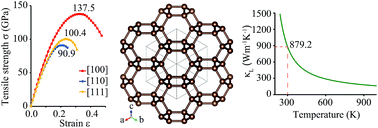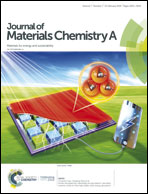Extremely high tensile strength and superior thermal conductivity of an sp3-hybridized superhard C24 fullerene crystal†
Abstract
Low-dimensional carbon allotropes could be used as fundamental building blocks to bottom-up build new materials with excellent properties. In this study, a lightweight sp3-hybridized carbon allotrope named 3d-C24 is suggested to be obtained by polymerizing fullerene C24 molecules. By means of first-principles density functional theory (DFT) calculations, 3d-C24 is confirmed to be not only dynamically and thermodynamically but also mechanically stable. Quasiharmonic calculations show that 3d-C24 has a quite low thermal expansion coefficient at room temperature and exhibits superior high-temperature dynamic stability even up to 2700 K. Although 3d-C24 is a lightweight carbon material, it has a very high Vickers hardness which is even higher than that of superhard cubic BN. The weak anharmonicity in bonding results in an abnormally low Grüneisen parameter at room temperature. Its tensile strength is extremely high and even superior to that of diamond in the [111] direction. Electronic structure calculations reveal that 3d-C24 is a semiconductor with an indirect bandgap of 3.65 eV. Anharmonic DFT calculations confirm that 3d-C24 has a very high thermal conductivity. In addition, infrared and Raman spectra are also investigated which could be used as a fingerprint to identify 3d-C24 from other carbon allotropes.



 Please wait while we load your content...
Please wait while we load your content...